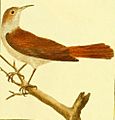Rufous Hornero facts for kids
The rufous hornero (Furnarius rufus) is a fascinating bird found across much of South America. It's known for its unique and strong nests, which look a lot like old-fashioned clay ovens. This special bird is even the national bird of Argentina!
Contents
About the Rufous Hornero
The rufous hornero is a medium-sized bird, usually about 18 to 20 centimeters (7 to 8 inches) long. It has reddish-brown feathers, which is where it gets the name "rufous." Its throat is often a lighter color, and it has a short, straight beak. These birds are quite common and can be seen in many different habitats. They live in open areas like grasslands, farms, and even city parks. You might spot them walking on the ground, looking for food.
What Do They Eat?
Rufous horneros mostly eat insects and other small creatures. They use their beaks to search for food in the soil. Their diet often includes beetles, ants, spiders, and larvae. Sometimes, they might also eat seeds. They are very good at finding food, even in busy areas.
Where Do They Live?
These birds are native to a large part of South America. You can find them in countries like Argentina, Brazil, Paraguay, Uruguay, and Bolivia. They prefer open landscapes with scattered trees or bushes. This allows them to easily find mud for their nests and food on the ground.
Amazing Nests
One of the most incredible things about the rufous hornero is its nest. It's not just any nest; it's a strong, oven-shaped structure made of mud. This is why it's sometimes called the "ovenbird."
How They Build Their Homes
Rufous horneros are expert builders. They mix mud with grass, plant fibers, and even animal hair. They use their beaks and feet to shape this mixture into a sturdy, round nest. The nest looks like a small, clay pot lying on its side. It has a small entrance hole, which often leads to a winding tunnel inside. This tunnel then opens into a larger chamber where the eggs are laid.
They build their nests on high, safe places. This can be on telephone poles, fence posts, or strong branches of trees. Building a nest can take a lot of time and effort, sometimes several days or even weeks. Once the mud dries, the nest becomes very hard and strong, protecting the birds from predators and bad weather.
Life Cycle and Reproduction
Inside their special mud nests, female rufous horneros lay their eggs. They usually lay between two and four white eggs. Both the male and female birds take turns sitting on the eggs to keep them warm. This is called incubation. After about 16 to 17 days, the baby birds hatch.
The parents work together to feed the chicks. They bring insects and other small creatures back to the nest. The young birds grow quickly. After about 23 to 26 days, they are ready to leave the nest. Even after they fledge (leave the nest), the young birds might stay with their parents for a while, learning how to find food and survive. Rufous horneros often reuse their nests or build new ones each breeding season.
Images for kids
See also
 In Spanish: Hornero común para niños
In Spanish: Hornero común para niños





